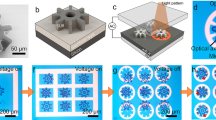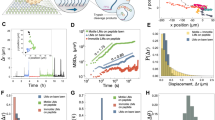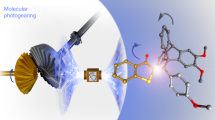Abstract
Gears are microfabricated down to diameters of a few micrometres. Natural macromolecular motors, of tens of nanometres in diameter, also show gear effects1. At a smaller scale, the random rotation of a single-molecule rotor encaged in a molecular stator has been observed2, demonstrating that a single molecule can be rotated with the tip of a scanning tunnelling microscope3,4 (STM). A self-assembled rack-and-pinion molecular machine where the STM tip apex is the rotation axis of the pinion was also tested5. Here, we present the mechanics of an intentionally constructed molecule-gear on a Au(111) surface, mounting and centring one hexa-t-butyl-pyrimidopentaphenylbenzene molecule on one atom axis. The combination of molecular design, molecular manipulation and surface atomic structure selection leads to the construction of a fundamental component of a planar single-molecule mechanical machine. The rotation of our molecule-gear is step-by-step and totally under control, demonstrating nine stable stations in both directions.
This is a preview of subscription content, access via your institution
Access options
Subscribe to this journal
Receive 12 print issues and online access
$259.00 per year
only $21.58 per issue
Buy this article
- Purchase on Springer Link
- Instant access to full article PDF
Prices may be subject to local taxes which are calculated during checkout




Similar content being viewed by others
References
Browne, W. R. & Feringa, B. L. Making molecular machines work. Nature Nanotechnol. 1, 25–35 (2006).
Gimzewski, J. K. et al. Rotation of a single molecule within a supramolecular bearing. Science 281, 531–533 (1998).
Stipe, B. C., Rezaei, M. A. & Ho, W. Inducing and viewing the rotational motion of a single molecule. Science 279, 1907–1909 (1998).
Stipe, B. C., Rezaei, M. A. & Ho, W. Coupling of vibrational excitation to the rotational motion of a single adsorbed molecule. Phys. Rev. Lett. 81, 1263–1266 (1998).
Chiravalloti, F. et al. A rack-and-pinion device at the molecular scale. Nature Mater. 6, 30–33 (2007).
Gross, L. et al. Tailoring molecular self-organization by chemical synthesis: Hexaphenylbenzene, hexa-peri-hexabenzocoronene, and derivatives on Cu (111). Phys. Rev. B 71, 165428 (2005).
De Sarkar, A., Manzano, C., Soe, W.-H., Chandrasekhar, N. & Joachim, C. Conformational dependence of tag induced intramolecular STM contrast in hexaphenylbenzene molecules. Surf. Sci. Lett. 603, L57–L61 (2009).
Barth, J. V., Brune, H., Ertl, G. & Behm, R. J. Scanning tunneling microscopy observations on the reconstructed Au(111) surface: Atomic structure, long-range superstructure, rotational domains, and surface defects. Phys. Rev. B 42, 9307–9318 (1990).
Eigler, D. M. & Schweizer, E. K. Positioning single atoms with a scanning tunneling microscope. Nature 344, 524–526 (1990).
Stroscio, J. A. & Eigler, D. M. Atomic and molecular manipulation with the scanning tunneling microscope. Science 254, 1319–1326 (1991).
Jung, T. A., Schlittler, R. R., Gimzewski, J. K., Tang, H. & Joachim, C. Controlled room-temperature positioning of individual molecules: Molecular flexure and motion. Science 271, 181–184 (1996).
Meyer, G. & Rieder, K.-H. Controlled manipulation of single atoms and small molecules with the scanning tunneling microscope. Surf. Sci. 377–379, 1087–1093 (1997).
Gross, L. et al. Trapping and moving metal atoms with a six-leg molecule. Nature Mater. 4, 892–895 (2005).
Ample, F. & Joachim, C. A semi-empirical study of polyacene molecules adsorbed on a Cu(110) surface. Surf. Sci. 600, 3243–3251 (2006).
Sautet, P. & Joachim, C. Calculation of the benzene on rhodium STM images. Chem. Phys. Lett. 185, 23–30 (1991).
Acknowledgements
We acknowledge the Agency for Science Technology and Research (A*STAR) for financial support provided through the Visiting Investigatorship Program (phase I) ‘Atomic Scale Technology Project’.
Author information
Authors and Affiliations
Contributions
C.M. and W.-H.S. were equally responsible for conducting the whole STM experiments, H.S.W. provided support with the experiments, A.G. and C.J. were responsible for the molecular design, A.G. for the chemical synthesis, F.A. and C.J. for the calculations, and N.C. and C.J. were responsible for the interpretation and planning of the experiments.
Corresponding authors
Supplementary information
Supplementary Information
Supplementary Information (PDF 421 kb)
Supplementary Information
Supplementary Movie 1 (AVI 1461 kb)
Supplementary Information
Supplementary Movie 2 (AVI 2072 kb)
Rights and permissions
About this article
Cite this article
Manzano, C., Soe, WH., Wong, H. et al. Step-by-step rotation of a molecule-gear mounted on an atomic-scale axis. Nature Mater 8, 576–579 (2009). https://doi.org/10.1038/nmat2467
Received:
Accepted:
Published:
Issue Date:
DOI: https://doi.org/10.1038/nmat2467



